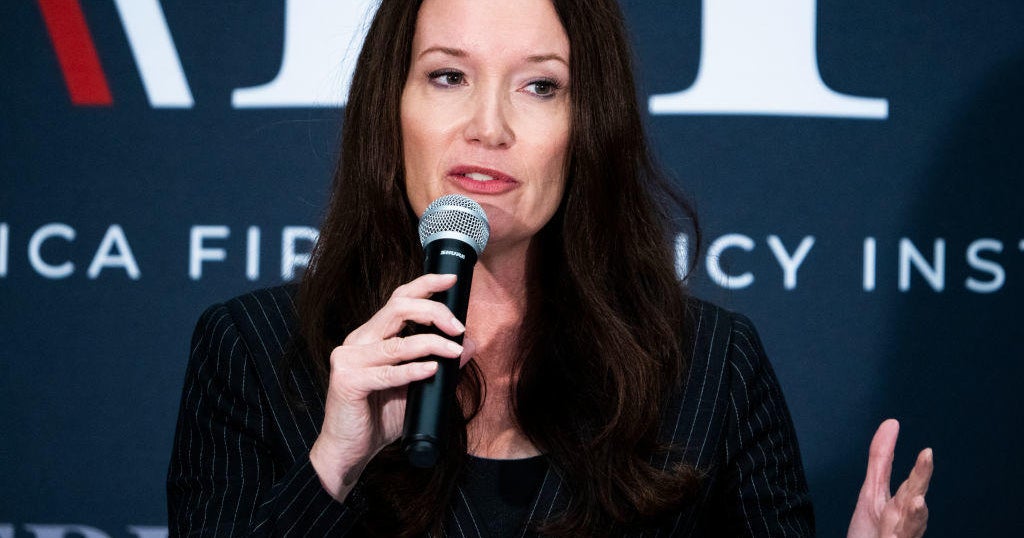CBS News
Migrant families worry over possible family separations if Trump wins | 60 Minutes

Former President Donald Trump’s pledge to implement mass deportation if he’s reelected has ignited fears of family separations.
Monica Camacho Perez and her family have lived and worked in the United States since coming illegally from Mexico more than 20 years ago. Camacho Perez teaches English as a second language to immigrant adults, and she also works in the public high schools. Her family lives in Baltimore.
“We are a normal family, like anybody else,” she said. “We go to church. We work every day. We pay taxes,” she said.
She’s among the more than 500,000 undocumented immigrants brought to the country as children who are protected from deportation under the Deferred Action for Childhood Arrivals program known as DACA.
“I’m the only one right now that’s, like, protected, while my parents are not, my brothers are not,” she said. “My brothers have children that are born here. So if they were to get deported, what will happen to their kids?”
Would families be separated if Trump’s reelected?
When asked whether there was a way to carry out mass deportations without separating families, Tom Homan, who led immigration enforcement during the first year-and-a-half of the Trump administration, said, “Of course there is. Families can be deported together.”
Like Camacho Perez’s nieces and nephews, more than four million U.S.-born children live with an undocumented parent.
60 Minutes
Asked why children should have to leave the country where they were born and raised, Homan said, “Because their parent absolutely entered the country illegally, had a child knowing he was in the country illegally. So he created that crisis.”
During Homan’s time leading ICE – in what became one of the most controversial policies of the Trump administration – at least 5,000 migrant children were forcibly separated from their parents when their parents were arrested at the border and prosecuted for crossing into the U.S. illegally.
Asked about published accounts saying that family separation at the border was his idea, Homan replied: “Not true. I didn’t write the memorandum to separate families. I signed the memo. Why’d I sign the memo? I was hoping to save lives. While you and I are talking right now, a child’s going to die in the border. . . . So we thought, ‘so maybe if we prosecute people, they’ll stop coming.'”
Trump has said Homan would be joining him in the new administration if he wins a second term. Asked if this family separation policy would be re-instituted then, Homan said, “I don’t know of any formal policy where they’re talking about family separations.”
60 Minutes
Asked whether it should be on the table, he replied, “It needs to be considered, absolutely.”
How that would happen given a court settlement reached late last year between the federal government and the American Civil Liberties Union is unclear. Under the settlement, the federal government is barred from separating migrant families at the border for the next eight years if the sole purpose is to prosecute the parents for entering the U.S. illegally.
“I can’t imagine living here without them.”
Back in Baltimore, Camacho Perez said she has given a lot of thought to what she would do if her parents were deported. Even though Baltimore is where she grew up, and she now owns her own home there, she thinks she would go back to Mexico with her parents if they were deported.
“They’re also part of my American dream,” she said. “And I can’t imagine living here without them.”
CBS News
A study to devise nutritional guidance just for you

It’s been said the best meals come from the heart, not from a recipe book. But at this USDA kitchen, there’s no pinch of this, dash of that, no dollops or smidgens of anything. Here, nutritionists in white coats painstakingly measure every single ingredient, down to the tenth of a gram.
Sheryn Stover is expected to eat every crumb of her pizza; any tiny morsels she does miss go back to the kitchen, where they’re scrutinized like evidence of some dietary crime.
Stover (or participant #8180, as she’s known) is one of some 10,000 volunteers enrolled in a $170 million nutrition study run by the National Institutes of Health. “At 78, not many people get to do studies that are going to affect a great amount of people, and I thought this was a great opportunity to do that,” she said.
CBS News
It’s called the Nutrition for Precision Health Study. “When I tell people about the study, the reaction usually is, ‘Oh, that’s so cool, can I do it?'” said coordinator Holly Nicastro.
She explained just what “precise” precisely means: “Precision nutrition means tailoring nutrition or dietary guidance to the individual.”
The government has long offered guidelines to help us eat better. In the 1940s we had the “Basic 7.” In the ’50s, the “Basic 4.” We’ve had the “Food Wheel,” the “Food Pyramid,” and currently, “My Plate.”
CBS News
They’re all well-intentioned, except they’re all based on averages – what works best for most people, most of the time. But according to Nicastro, there is no one best way to eat. “We know from virtually every nutrition study ever conducted, we have inner individual variability,” she said. “That means we have some people that are going to respond, and some people that aren’t. There’s no one-size-fits-all.”
The study’s participants, like Stover, are all being drawn from another NIH study program called All Of Us, a massive undertaking to create a database of at least a million people who are volunteering everything from their electronic health records to their DNA. It was from that All of Us research that Stover discovered she has the gene that makes some foods taste bitter, which could explain why she ate more of one kind of food than another.
Professor Sai Das, who oversees the study at Tufts University, says the goal of precision nutrition is to drill down even deeper into those individual differences. “We’re moving away from just saying everybody go do this, to being able to say, ‘Okay, if you have X, Y and Z characteristics, then you’re more likely to respond to a diet, and somebody else that has A, B and C characteristics will be responding to the diet differently,'” Das said.
It’s a big commitment for Stover, who is one of 150 people being paid to live at a handful of test sites around the country for six weeks – two weeks at a time. It’s so precise she can’t even go for a walk without a dietary chaperone. “Well, you could stop and buy candy … God forbid, you can’t do that!” she laughed.
While she’s here, everything from her resting metabolic rate, her body fat percentage, her bone mineral content, even the microbes in her gut (digested by a machine that essentially is a smart toilet paper reading device) are being analyzed for how hers may differ from someone else’s.
Nicastro said, “We really think that what’s going on in your poop is going to tell us a lot of information about your health and how you respond to food.”
CBS News
Stover says she doesn’t mind, except for the odd sounds the machine makes. While she is a live-in participant, thousands of others are participating from their homes, where electronic wearables track all kinds of health data, including special glasses that record everything they eat, activated when someone starts chewing. Artificial intelligence can then be used to determine not only which foods the person is eating, but how many calories are consumed.
This study is expected to be wrapped up by 2027, and because of it, we may indeed know not only to eat more fruits and vegetables, but what combination of foods is really best for us. The question that even Holly Nicastro can’t answer is, will we listen? “You can lead a horse to water; you can’t make them drink,” she said. “We can tailor the interventions all day. But one hypothesis I have is that if the guidance is tailored to the individual, it’s going to make that individual more likely to follow it, because this is for me, this was designed for me.”
For more info:
Story produced by Mark Hudspeth. Editor: Ed Givnish.
“Sunday Morning” 2024 “Food Issue” recipe index
Delicious menu suggestions from top chefs, cookbook authors, food writers, restaurateurs, and the editors of Food & Wine magazine.
CBS News
A new generation of shopping cart, with GPS and AI

Watch CBS News
Be the first to know
Get browser notifications for breaking news, live events, and exclusive reporting.
CBS News
“All hands on deck” for Idaho’s annual potato harvest

Watch CBS News
Be the first to know
Get browser notifications for breaking news, live events, and exclusive reporting.














